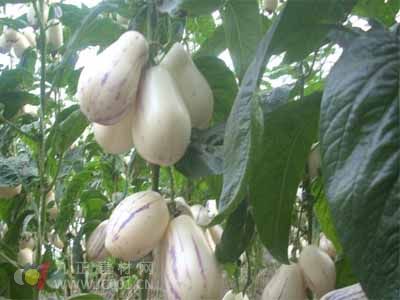**Prevention and Treatment of Ginseng Fruit Black Spot Disease**
**Symptoms:**
The disease primarily affects the leaves of ginseng plants. Initially, small black spots appear on the leaf surface, which gradually expand into nearly circular or irregular shapes. As the infection progresses, the lesions often merge into larger areas, leading to leaf drying or death.
**Morphological Characteristics of the Pathogen:**
The pathogen is an *Alternaria* species, a type of fungus. The mycelium is filamentous with septa. Conidiophores emerge from stomata in clusters, typically 1–5 per cluster. These stalks are cylindrical or short rod-shaped, dark brown in color, and have 1–4 septa. Their size ranges from 30.6–104 μm in length and 4.3–9.19 μm in width. The conidia are long-oval or inverted stick-shaped, pale yellow, measuring 85.6–146.5 μm in length and 11.7–22 μm in width. They have 1–9 septa, with 7–13 cells separated by walls. A long, clear mucilage is present at the top, and most spores have 1–3 septa, measuring 6.3–74 μm × 3–7.4 μm. The pathogen can grow between 1°C and 45°C, with optimal development occurring at 26–28°C. In water, spores begin to germinate within 1–2 hours at 6–24°C, while at 28–30°C, germination occurs in just 35–45 minutes. Each spore can produce 5–10 germ tubes.

**Disease Characteristics:**
The pathogen overwinters on infected plant parts and seeds, spreading via hyphae or conidia. It can directly invade through stomata, lenticels, or the epidermis, causing initial infections that develop into visible lesions after 2–3 days. Within 3–4 days, new conidia are produced, and the disease spreads through wind and rain. When the average temperature remains around 21°C for five consecutive days and relative humidity exceeds 70% for an extended period, the disease becomes active. Rainy seasons significantly influence the spread, as rainfall increases humidity and promotes disease development. Additionally, the pathogen is a facultative saprophyte, meaning it can survive in soil when ginseng is improperly managed or replanted without sufficient base fertilizer.
**Control Methods for Ginseng Fruit Black Spot Disease:**
1. **Ecological Prevention:** In protected cultivation, focus on managing temperature and humidity. In early spring, daytime temperatures may range from 20–25°C, while nighttime temperatures drop to 12–15°C. High humidity (over 80%) leads to dew formation, creating favorable conditions for disease spread. Adjusting greenhouse conditions can help reduce the risk.
2. **Dust Method Application:** At the early stage of infection, apply 5% chlorothalonil powder using the dust method at a rate of 1 kg per 667 square meters, repeating every 9 days for 3–4 applications.
3. **Fumigation:** Use 45% chlorothalonil or 10% quick-acting smoke agents at a rate of 200–250 grams per acre.
4. **Fertilization Management:** Apply full base fertilizer according to soil test recommendations and provide timely topdressing to enhance plant resistance.
5. **Preventive Spraying:** Before the disease appears, spray 50% phlegm hyacinth powder diluted at 1000 times, 75% Dake Ning (chlorocide) WP at 600 times, 80% spray WP at 600 times, or 70% Dyson Mn-Zn wettable powder at 500 times.
6. **Special Agents:** Consider using bacterial agents like ampicillin ester for enhanced control.
By combining these strategies, farmers can effectively manage ginseng fruit black spot disease and protect their crops from significant losses.
LED Dial Track Light 3CCT,LED Aluminum Dial Track Light 3CCT,LED Track Light 3CCT,LED Aluminum Track Light 3CCT
Foshan Extrlux Co., Ltd. , https://www.extrlux.com